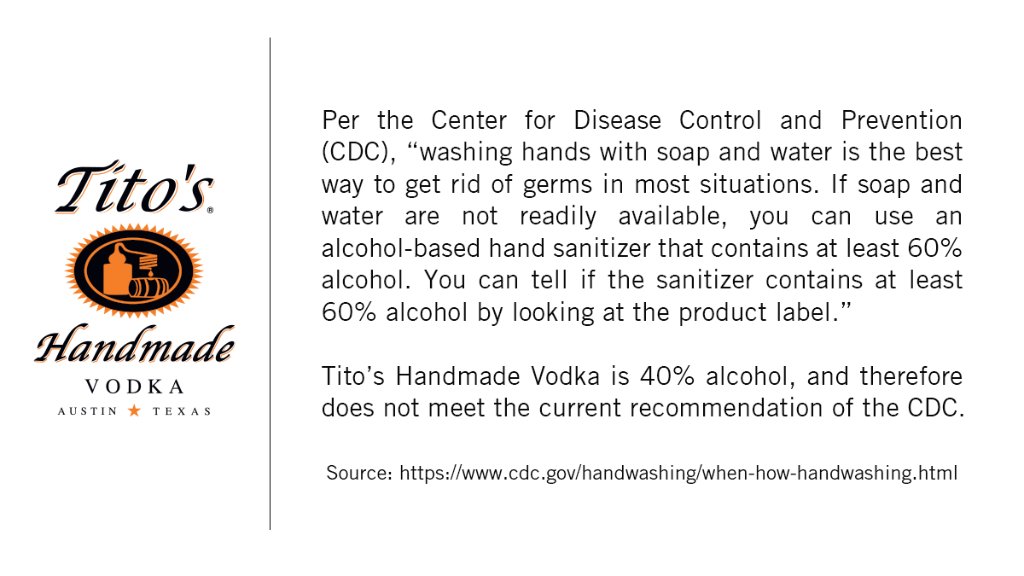Almost as soon as the news broke about COVID-19 (the official name for the illness caused by the virus), conspiracy theories, hoaxes, and misinformation spread like wildfire online — even from some traditionally reputable information sources.
Some of the bad information is being spread for nefarious reasons — to continue to sow mistrust in agencies that are supposed to protect the public. We're going to leave those to more authoritative media sources.
Some of the bad information, however, is being spread with the best of intentions, even if it is absolutely wrong.
Here are seven myths or hoaxes that we found, and what the reality is.
First, let's get the lead sentence out of the way.
MYTH: If you can’t get hand sanitizer, you can make your own with vodka.
REALITY: Thanks to several social media posts, including one originally linked to Good Housekeeping, Tito’s Handmade Vodka has spent two days on Twitter telling people, individually, not to use their vodka to make hand sanitizer.
“Per the CDC, hand sanitizer needs to contain at least 60 percent alcohol. Tito’s Handmade Vodka is 40 percent alcohol, and therefore does not meet the current recommendation of the CDC,” Tito’s tweets say.
You’d need a very high alcohol volume to make a homemade mix work, because you’re diluting the alcohol mix. You’d need to use either rubbing alcohol (which is cheaper than vodka, seriously), or at least 180 proof alcohol in your mixture. And you need to make sure your mix is just right.
There’s an easier way to disinfect your hands: Just wash them with water and soap.
By the way, the Good Housekeeping article being shared does not seem to have the vodka hand sanitizer recipe listed in it anymore.
MYTH: It’s just the flu.
REALITY: The two viruses have similarities, like being respiratory illnesses. But they’re not the same.
COVID-19 is caused by a virus in the coronavirus family, which is not the flu. It’s a different type of virus entirely. SARS, for instance, is in the same family as COVID-19's coronavirus.
The influenza virus includes several different strains of the flu.

LEFT: What COVID-19's coronavirus looks like under a microscope. RIGHT: What influenza virus looks like. (Images courtesy of CDC)
Infectious disease experts at the World Health Organization say people with the flu can spread the virus even though they are not showing symptoms.
So far, it appears COVID-19 generally does not spread from one person to the next until people show symptoms.
WHO officials also think containment in China has brought down the number of new cases of COVID-19. WHO officials say containment doesn’t work with seasonal flu the way it seems to be working for COVID-19.
“We have never seen before a respiratory pathogen that’s capable of community transmission but at the same time which can also be contained with the right measures,” said WHO Director-General Tedros Adhanom Ghebreyesus on March 3. “If this was an influenza epidemic, we would have expected to see widespread community transmission across the globe by now and efforts to slow it down or contain it would not be feasible.”
That’s why there is so much talk about finding people with symptoms, getting them tested, and isolating them. That’s also why events with large gatherings have been postponed or canceled.
MYTH: You can be infected with COVID-19 from products manufactured in countries reporting outbreaks, including China.
REALITY: The general belief is that COVID-19 is transmitted by droplets from an infected person’s sneeze or cough. It’s thought the virus can last up to several days outside the body, depending on the type of surface, but the World Health Organization believes the virus will not last long on a surface that’s been traveling or exposed to different conditions.
MYTH: Spraying alcohol or chlorine on your body will kill COVID-19.
REALITY: Alcohol-based cleaners and chlorine bleach-based cleaners can be helpful in disinfecting surfaces, but spraying alcohol or chlorine on your body is not only ineffective, it can be dangerous to the mucous membranes in your nose, eyes, and mouth, according to the WHO.
While we’re at it, swallowing or gargling bleach, even bleach-diluted with other liquids, is not going to help you.
According to Johns Hopkins Medicine, swallowing or gargling acetic acid, ethanol, salt water, or steroids also are ineffective. And so are your essential oils.
MYTH: Antibiotics or over-the-counter medicines can prevent or treat COVID-19.
REALITY: Antibiotics don’t work against viruses, so they will not work on COVID-19. Antivirals aren't thought to work to treat COVID-19, because the coronavirus that causes it is so new and still under study. However, if some nighttime medicines or other over-the-counter cold remedies help provide symptom relief, World Health Organization says you should use those.
MYTH: Pets can get COVID-19 and pass it on to you.
REALITY: Pets are susceptible to coronaviruses, but there’s no evidence yet that you can get the new coronavirus infection, COVID-19, from them, according to the WHO. Still, you should still continue to wash your hands with soap and water after contact with pets.
MYTH: Younger people and children are not susceptible to COVID-19.
REALITY: Older people and people with preexisting medical conditions are more likely to be become severely ill. But WHO says people of all ages can become infected.





No comments:
Post a Comment